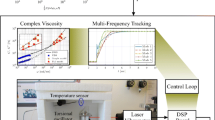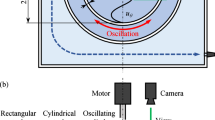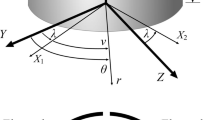Abstract
A frequency method of measuring the dynamic viscosity of rheological media is outlined for the example of a magnetorheological fluid. The method is based on the operational principle of a rotary viscosimeter, in which the torsion angle depends on the characteristics of the viscoelastic medium.
Similar content being viewed by others
Avoid common mistakes on your manuscript.
OUTLINE OF METHOD
Measurement methods have been developed for the small torques of shafts in various machines. These involve specific systems [1–3]: in particular, rotary viscosimeters [4–7]. In the latter, liquid viscosity is determined by measuring the torque in terms of the twist angle of a sprung torsion rod [6]. The phase shift between the reference rod and the displaced rod as a result of twisting is determined on the basis of the speed of the viscosimeter shaft, by measuring time intervals [4, 5, 7].
To measure the viscosity of the magnetorheological fluids used in vibrational shielding systems with magnetorheological converters, a new method has been proposed for measuring the torque of torsional shafts [8–13]. In that method, the torsional strain is determined by means of a broadband frequency modulation [6, 8, 14–16].
In the present work, we use two high-frequency sweep generators. The generators producing the reference signal and the displaced signal are denoted by Gr and Gd, respectively (Fig. 1).
Functional diagram of a rotary viscosimeter with frequency-based measurement of the torque: (1) electric motor; (2) measuring rotor; (3) elastic torsion rod; (4, 5) modulation disks; (6, 7) optical pairs; (8, 9) pulse converters; (10, 11) modulators for generators; (12) generator of reference signal (Gr); (13) generator of displaced signal (Gd); (14) mixer; (15) low-frequency filter; (16) beat-frequency counter; (17) test liquid; (18) measuring vessel.
In Fig. 2, we show the frequency contours of the reference signal fr and displaced signal fd [8, 16].
In determining the torques of the rotating torsional shafts by the given method, their twisting leads to a frequency shift between the reference signal fr and displaced signal fd (Fig. 3a) [6, 8, 14–16].
In the rotary viscosimeter, the dynamic viscosity of a magnetorheological fluid is determined by means of an elastic torsion rod rather than a torsional shaft [6]. The viscous drag of the magnetorheological fluid on the viscosimeter’s rotor produces a torque that twists the elastic torsion rod [7]. We may use a spring as the elastic torsion rod. At the maximum torque, the spring’s rigidity ensures mutual displacement of the modulation disks by no more than 3° [4–6].
An opposing torque at the elastic torsion rod (sensitive element) is created in determining the torque at the viscosimeter’s rotor. That torque may be determined by the frequency method of measuring the torque of rotating torsional shafts [6, 8, 14–16].
The reference frequency-modulated (FM) signal from Gr is described as follows [17, 18]
where fr0 is the central frequency of the reference FM signal from Gr; Δfm is the frequency deviation; and Tm is the period of frequency modulation.
As the elastic torsion rod of the viscosimeter twists, the signal fd displaced in time ttw takes the form [17, 18]
where fd0 is the central frequency of the displaced FM signal from Gd.
The signal fd is delayed relative to fr by the twisting time ttw of the elastic torsion rod: ttw = Δφ/Ωro. Thus, fd(t) = fr(t − ttw).
In torque measurement with zero beats, the displaced signal fd is summed with the reference signal at the mixer input. At the mixer output, a low-frequency filter isolates the beat frequency between the reference signal fr and displaced signal fd at frequency Fb0, which is equal to the absolute value |FD0| of the frequency difference between those signals (Figs. 3a and 3b). Taking account of the Eqs. (1) and (2), in ascending intervals Tm/2, we may write this signal in the form [17, 18]
From Eq. (1), we obtain the maximum frequency difference [17–19]
Thus, by isolating the fundamental beat frequency at the mixer output corresponding to the reference and displaced FM signals, the true torque of the rotary viscosimeter may be measured.
RESOLUTION AND ACCURACY OF THE METHOD
The FM frequencies of the generators 12 and 13 (Fig. 1) are summed in mixer 14. The spectrum of the transformed beat signal (Fig. 3c) at the mixer output for many twist angles \(\Delta \varphi \) of the viscosimeter’s elastic torsion rod may be regarded as the superposition of the spectra of several individual signals (Figs. 3d and 3e) [19].
Consider the structure of a transformed beat signal (Fig. 3). We assume that the measurement time Tme is much greater than the frequency-modulation period Tm: Tme \( \gg \) Tm. Then the beat signal consists of individual pulses with period Tm.
These pulses have a discrete spectrum [19]. The interval between the individual spectral lines corresponds to the repetition frequency: Fm = 1/Tm. The amplitudes АK of the spectral components of the beat signals are accommodated within the envelope of the continuous spectrum of a single pulse — in other words, within the function \({{\sin{\kern 1pt} x} \mathord{\left/ {\vphantom {{sin{\kern 1pt} x} x}} \right. \kern-0em} x}\) (Fig. 4).
The spectrum of a single pulse is concentrated close to the frequency Fb0. The presence of inversion zones (phase shifts) within the beat signal (Fig. 3a) expands the spectral envelope. There is a phase shift (inversion zone) in the center of the interval Tm [19]. Accordingly, we may consider the pulse within the interval consisting of two pulses of length Tm/2. The spectral envelope of each pulse is doubled, so that the primary lobe occupies the frequency band from Fb0 − 2Fm to Fb0 + 2Fm. Together with the basic spectral line Fb0, we now see secondary lines. Thus, the theoretical spectrum of the transformed beat signal consists of discrete lines concentrated around the frequency Fb0 (Fig. 4) [19]. Decrease in the modulation frequency Fm increases the concentration of spectral lines of the transformed signal close to frequency Fb0.
The spectrum of the actual transformed beat signal with symmetric sawtooth frequency modulation is shown in Fig. 5. The central frequency is Fb0 = 1250 Hz. The beat frequency Fb0, which determines the twist angle \(\Delta \varphi \) of the elastic shaft, is measured from the position of the spectral line of maximum amplitude. In the general case, that need not be the frequency Fb0 (Figs. 4 and 5).
However, any change in \(\Delta \varphi \) may only be detected from the change in amplitude of the spectral line [19]. This change corresponds to Fb0. Hence, with a discrete spectrum, the procedural error in measuring the twist angle \(\Delta \varphi \) is
For example, with frequency deviation Δfm = 20 MHz and modulation frequency Fm = 2.5 Hz (the rotational frequency of the elastic torsion rod), the procedural error at Δφmax is 4 × 10−7 rad (about 1″). This error may be neglected.
To decrease the error, we must increase the frequency deviation. As a rule, that is not difficult [17, 19].
With large modulation index \(m\) = Δfm/2Fm, the frequency deviation is close to the width of the FM spectrum; for example, with sinusoidal modulation, m = 0.01. Thus, to decrease the procedural error, we must expand the spectrum of FM vibrations. The potential accuracy in torque measurement is then determined by the width of the frequency band for the signals from Gr and Gd [19].
That corresponds to minimum displacement time δtdis.min of the viscosimeter’s modulation disks mounted on the elastic torsion rod
According to Eq. (4), when Δfm = 20 MHz, the minimum displacement time of the modulation disks is 25 × 10−9 s. In that case, the beat frequency is determined by the modulation frequency: for example, Fb0min = 2.5 Hz when Fm = 2.5 Hz.
The frequency deviation with the required procedural error is found from Eq. (3) and the relation
The values of δtdis.max and Δφmax depend on the mechanical properties of the elastic torsion rod—that is, on the shear modulus G and density ρ of the material, which determine its strength [6, 8, 14–16].
To assess the resolution and accuracy of the frequency method of viscosity measurement for magnetorheological fluids, we need to consider the beat-frequency spectrum for each time corresponding to a specific discrete value of the twist angle Δφ. To that end, we pass from serial to parallel spectral analysis [19].
In parallel spectral analysis, all the successive values of Δφ appear simultaneously at the input of the parallel analyzer, at some specific time. There is a set of discrete filters limiting the ranges of frequency (Fb0min–Fb0max), twist angle (Δφmin–Δφmax), torque (Mto.min–Mto.max), and dynamic viscosity of the magnetorheological fluid (ηmin–ηmax), as illustrated in Fig. 6 [19].
If the bandwidth of each filter is ΔFf, the number required is nf = (Fb0max − Fb0min)/ΔFf.
ASSESSING THE RESOLUTION AND ACCURACY
Two twist angles may be distinguished if the difference between their beat frequencies Fb01 and Fb02 is greater than the transmission band of the filter: Fb02 − Fb01 ≥ ΔFf, where
Thus, the resolution condition is
Then the resolution is [17, 19]
The filter’s bandwidth ΔFf must be consistent with the time of the corresponding transformed beat signal, which consists of individual radio pulses with carrier frequency Fb0 (Figs. 3b and 3c). For example, with symmetric sawtooth modulation, the pulse length may be assumed to be Tm/2 [19]. Therefore, the transmission band of the matched filter is ΔFf.ma ≈ 2/Tm. Then the potential resolution for symmetric sawtooth modulation of the signals from Gr and Gd (Fig. 2) is [17, 19]
In that case, the resolution matches the discreteness in measuring the twist angles Δφ of the elastic torsion rod and is determined by the frequency bandwidth of the reference and displaced signals from Gr and Gd—that is, the frequencies fr(t) and fd(t). This indicates that the resolution with respect to Δφ is ultimately determined by the spectral width of the transformed beat signal [19].
If the mean spectral frequency Fb0 of the fundamental beat frequencies with variation in the twist angles falls in the frequency band ΔFf of the filter, then we may assume that Fb0 is equal to the filter’s resonant frequency.
Suppose that Fb0 may correspond with the same probability to any value within the band ΔFf. We know that, with uniform distribution density of a random quantity within a given interval, its standard deviation is equal to that interval divided by \({\text{2}}\sqrt {\text{3}} \) [19]. Therefore, from Eq. (5)
To simplify the spectral analysis, we may decrease the number of filters, while increasing their transmission band ΔFf. However, that decreases the resolution and accuracy [19].
To ensure that the twist angles of the elastic torsion rod and the frequency Fb0 correspond in making use of the potential resolution, we must employ a very linear modulation law. The required linearity is assessed in terms of the relative deviation of the rate of frequency variation: γ = ΔFb0/Fb0.
If
where nf is the number of filters for the corresponding twist angles, then γ = 0.25% when (Fb0max − Fb0min)/Fb0 = 0.5 and nf = 100. With the electronic components currently available, that is perfectly acceptable 19].
DETERMINING THE DYNAMIC VISCOSITY ON THE BASIS OF THE TWIST ANGLE
In measuring the dynamic viscosity of a magnetorheological fluid in a rotary viscosimeter, the torque applied to the internal cylinder is determined from the formula
where \({{M}_{k}}\) is the torque on the rotor; \(F\) is the force applied to the cylinder; and R is its radius [4–8, 20].
The force on the internal cylinder is determined from Newton’s law [4, 5, 20]
where Ωro = 2πFro is the angular velocity of the cylinder; S is its working area; \(l\) is the gap between the sleeve and the internal cylinder; and η is the viscosity of the magnetorheological fluid.
Substituting Eq. (7) into Eq. (6), we obtain [4, 5]
If Ωro = 2πFro, and the cylinder dimensions are constant, then the torque \({{M}_{k}}\) is equal to the retarding torque Mre due to the viscous drag of the magnetorheological fluid, which is proportional to its viscosity η [4, 5]
where the coefficient kdi = SR/l depends on the dimensions of the sleeve and rotor; S is the working area of the cylinder; R is its radius; and \(l\) is the gap between the sleeve and the rotor.
Hence, knowing the torque on the internal cylinder, we may determine the dynamic viscosity of the magnetorheological fluid [4–8, 20].
In determining the dynamic viscosity on the basis of the frequency, the torque on the viscosimeter’s turning torsional shaft is calculated from the formula [6, 8, 14–16]
where (Fb0/2Δfm)2π = Δφ is the twist angle (rad) of the viscosimeter’s torsional shaft [6, 8, 14–16].
Equating the torques in Eqs. (8) and (9), we find that
From Eq. (10), we may determine the dynamic viscosity η of the magnetorheological fluid in the rotary viscosimeter [6, 8]
Thus, on the basis of the frequency method of measuring the torque at the torsion shaft, the change in dynamic viscosity of the magnetorheological fluid under the action of external factors may be assessed so as to permit preliminary regulation of the working fluid in the magnetically controlled damper, taking account of the magnetic field.
REFERENCES
Ivanov, G.M., Novikov, V.I., Khmelev, V.V., and Ermak, V.N., Torque sensors in electric drive systems, Elektrotekh. Prom-st’, Ser. Elektroprivod, 1987, no. 3 (19).
Kostomarov, A.S., Moguchev, M.V., and Mikitchenko, A.Ya., Feedback sensors for electric drive, Vestn. Orenb. Gos. Univ., 2001, no. 3, pp. 117–121.
Kasatkin, B.S., Kudrin, A.B., Lobanov, L.M., et al., Eksperimental’nye metody issledovaniya deformatsii i napryazhenii: Spravochnoe pocobie (Experimental Studies of Deformations and Stresses: Handbook), Kiev: Naukova Dumka, 1981.
Korganova, O.G. and Kuznetsov, V.A., Automatic determination of viscosity by rotary viscosimeter VRTs, Vestn. Samar. Gos. Tekh. Univ., Ser. Tekh. Nauki, 2019, no. 2 (33), pp. 88–97.
Korganova, O.G. and Kuznetsov, V.A., A rotary viscosimeter, Vestn. Samar. Gos. Tekh. Univ., Ser. Tekh. Nauki, 2012, no. 1 (33), pp. 55–60.
Gordeev, B.A., Okhulkov, S.N., Plekhov, A.S., et al., Measurement of the dynamic viscosity of magnetorheological fluids in a rotary viscometer by the frequency method, in Aktual’nye problemy elektroenergetiki (Current Problems in Electrical Energetics), Nizhny Novgorod, 2017, pp. 77–87.
Pirogov, A.N. and Donya, D.V., Inzhenernaya reologiya (Engineering Rheology), Kemerovo: Kemerovsk. Tekhnol. Inst. Pishch. Prom-sti, 2004.
Gordeev, B.A., Okhulkov, S.N., Plekhov, A.S., and Shokhin A.E., Torque on a shaft connected to the driveshaft by a magnetorheological coupling, Russ. Eng. Res., 2018, vol. 38, no. 12, pp. 962–967.
Gordeev, B.A., Okhulkov, S.N., and Sinev, A.V., Control of a magnetorheological transformer by means of a rotating magnet field, Russ. Eng. Res., 2019, vol. 39, no. 2, pp. 106–109.
Gordeev, B.A., Ermolaev, A.I., Okhulkov, S.N., Sinev, A.V., and Shokhin, A.E., A magnetorheological transformer controlled by a rotating magnetic field, J. Mach. Manuf. Reliab., 2018, vol. 47, no. 4, pp. 324–329.
Gordeev, B.A., Okhulkov, S.N., Plekhov, A.S., et al., Flow and relaxation of magnetorheological liquid in throttle channels of hydraulic bearings, Vestn. Mashinostr., 2015, no. 7, pp. 32–38.
Gordeev, B.A., Maslov, V.G., Okhulkov, S.N., and Osmekhin, A.N., On developing a magnetorheological transformer that operates in orthogonal magnetic fields, J. Mach. Manuf. Reliab., 2014, vol. 43, no. 2, pp. 99–103.
Gordeev, B.A., Erofeev, V.I., Sinev, A.V., and Mugin, O.O., Sistemy vibrozashchity s uspol’zovaniem inertsionnosti i dissipatsii reologicheskikh sred (Vibration Protection Systems with Inertia and Dissipation of Rheological Media), Moscow: Fizmatlit, 2004.
Gordeev, B.A., Okhulkov, S.N., Plekhov, A.S., et al., Measuring the torque of rotating shafts, Russ. Eng. Res., 2015, vol. 35, no. 5, pp. 315–319.
Gordeev, B.A., Bugaiskii, V.V., Erofeev, V.I., and Okhulkov, S.N., Frequency method of measuring torsional deformation on rotating shafts of machines and mechanisms, Vestn. Volzhsk. Gos. Akad. Vodn. Transp., 2006, no. 16, pp. 62–70.
Okhulkov, E.N. and Okhulkov, S.N., RF Patent 2 196 309, 2003.
Viktorov, V.A., Lunkin, B.V., and Sovlukov, A.S., Radiovolnovye izmereniya parametrov tekhnologicheskikh protsessov (Radio Wave Measurements of Technological Parameters), Moscow: Energoizdat, 1989.
Lezin, Yu.S., Vvedenie v teoriyu i tekhniku radiotekhnicheskikh sistem (Introduction into the Theory and Engineering of Radio Engineering Systems), Moscow: Radio i Svyaz’, 1986.
Finkel’shtein, M.I., Osnovy radiolokatsii (Fundamentals of Radiolocation), Moscow: Radio i Svyaz’, 1983.
Lozovskii, V.N., Kurs fiziki (Course of Physics), Lozovskii, V.N., Ed., Moscow: Lan’, 2009.
Funding
Financial support was provided by the Russian Foundation for Basic Research (project 18-48-520010)-r_a).
Author information
Authors and Affiliations
Corresponding authors
Ethics declarations
The authors declare that they have no conflicts of interest.
Additional information
Translated by B. Gilbert
About this article
Cite this article
Belyaev, E.S., Vanyagin, A.V., Gordeev, B.A. et al. Frequency Method of Measuring the Viscosity of Magnetorheological Fluids in a Rotary Viscosimeter. Russ. Engin. Res. 41, 19–24 (2021). https://doi.org/10.3103/S1068798X21010032
Received:
Revised:
Accepted:
Published:
Issue Date:
DOI: https://doi.org/10.3103/S1068798X21010032










